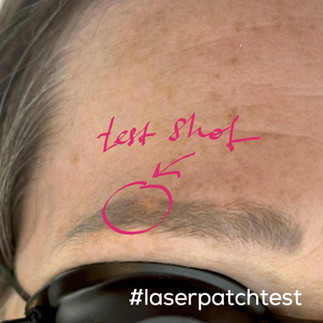Patch test - is it worth my time??!
- Elena NOVO

- Feb 8, 2024
- 2 min read
Before attending your laser tattoo removal session you will be asked to visit the studio for a patch test. Not only it is a LEGAL requirement in UK but also an important step towards safe and efficient treatment!
Patch test itself takes no more that few second of your time.
How is it done?
During the patch test, a small section of the tattoo exposed to a laser beam to assess the skin's responses and potential alterations in the colour of the targeted pigment.
NB??? Did you know that certain red pigments may transition to a grey hue when exposed to laser radiation? This phenomenon is known as paradoxical darkening. While grey brows might be considered a more favourable colour than red, imagine if this occurred with lips—how would you feel about having grey lips?
This involves the following steps:
1. Cleansing the skin.
2. Application of the laser: A small section of the tattoo is targeted with the laser.
3. Observation period and evaluation : After the laser exposure, the skin is closely monitored for any adverse reactions, such as excessive redness, swelling, blistering, or changes in pigmentation.
Why do we run a patch test?
The importance of a patch test lies in several factors:
1. Skin sensitivity assessment: It helps identify individuals who may be more prone to adverse reactions or complications from the laser treatment, such as those with sensitive skin or underlying skin conditions.
2. Determining optimal laser settings: The patch test allows for adjustments in laser parameters, such as energy intensity and pulse frequency to customize the treatment based on the individual needs.
3. Predicting treatment outcomes & minimizing risks: By observing how the skin responds to the laser, we can anticipate the effectiveness and prevent adverse reactions (burns, skin damage ,scarring, hyperpigmentation or unwanted colour changes, etc.)
Overall, a laser tattoo removal patch test is a crucial preliminary step that ensures the safety, efficacy, and successful outcomes of the tattoo removal procedure while minimizing the risk of adverse effects for the individual undergoing treatment.









Comments